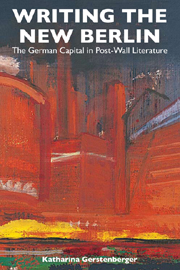Book contents
- Frontmatter
- Contents
- Acknowledgments
- Introduction: Newness and Its Discontents: Berlin Literature in the 1990s and Beyond
- 1 Erotic Sites: Sexual Topographies after the Wall
- 2 Bodies and Borders: The Monsters of Berlin
- 3 Multicultural Germans and Jews of Many Cultures: Imagining “Jewish Berlin”
- 4 Goodbye to East Berlin
- 5 Looking for Perspectives: The Construction at Potsdamer Platz
- Conclusion
- Bibliography
- Index
5 - Looking for Perspectives: The Construction at Potsdamer Platz
Published online by Cambridge University Press: 05 February 2013
- Frontmatter
- Contents
- Acknowledgments
- Introduction: Newness and Its Discontents: Berlin Literature in the 1990s and Beyond
- 1 Erotic Sites: Sexual Topographies after the Wall
- 2 Bodies and Borders: The Monsters of Berlin
- 3 Multicultural Germans and Jews of Many Cultures: Imagining “Jewish Berlin”
- 4 Goodbye to East Berlin
- 5 Looking for Perspectives: The Construction at Potsdamer Platz
- Conclusion
- Bibliography
- Index
Summary
es wird dauern, bis der berlin-pegel wieder sinkt und etwas darunter (eine hauptstadt? eine festungsanlage? ein daimler-benz-klotz?) sichtbar wird.
[it will take time until the berlin level goes down again and something underneath (a capital? a fortress? a daimler-benz-block?) becomes visible.]
— Kathrin Röggla, “Die Berufsjugendlichen”The post-unification decade was as much about the physical rebuilding of Berlin as it was about the interpretation of this process and its outcomes. Berlin texts of the post-unification decade attempt to capture a city in transition, participating in the interpretative process that accompanied the massive building projects. The engagement with national history is one contested arena in this construction of meaning; the pressures and opportunities of globalization are the other.
In the 1990s Potsdamer Platz was Europe's largest construction site. It was also one of those most analyzed. The tension between tradition and innovation in this new architecture inspired the debates about the importance of the German past and visions of the future. The majority of literary texts that refer to the construction there emphasize the need to incorporate the past into contemporary German consciousness and criticize either a lack of historical awareness or the choice of historical reference. The frequent association of Potsdamer Platz with globalization, however broadly understood, is not only an economic argument but also a warning against forgetting the Nazi past, lest Germany lose a defining element of its identity.
- Type
- Chapter
- Information
- Writing the New BerlinThe German Capital in Post-Wall Literature, pp. 141 - 169Publisher: Boydell & BrewerPrint publication year: 2008

